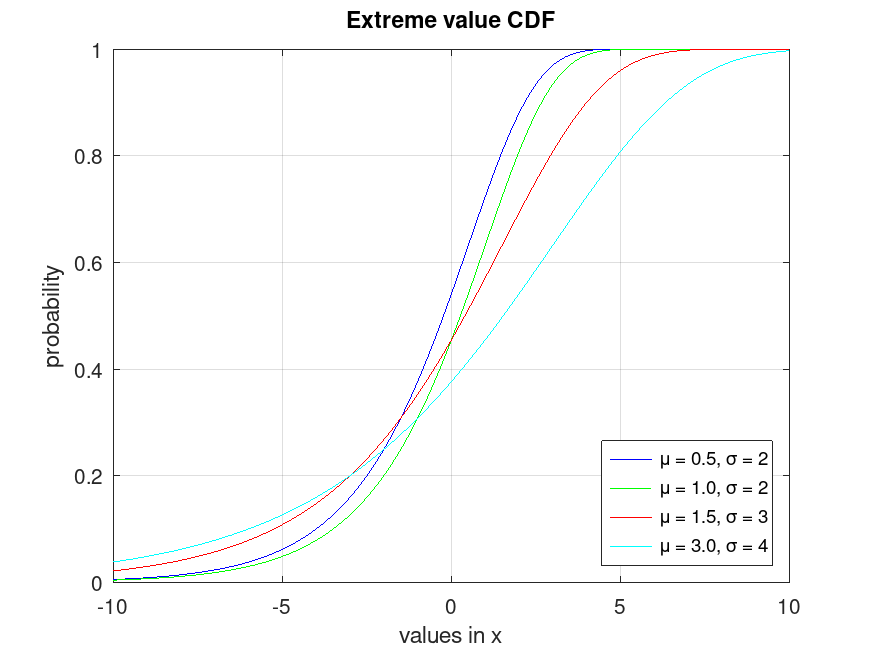Categories &
Functions List
- BetaDistribution
- BinomialDistribution
- BirnbaumSaundersDistribution
- BurrDistribution
- ExponentialDistribution
- ExtremeValueDistribution
- GammaDistribution
- GeneralizedExtremeValueDistribution
- GeneralizedParetoDistribution
- HalfNormalDistribution
- InverseGaussianDistribution
- LogisticDistribution
- LoglogisticDistribution
- LognormalDistribution
- LoguniformDistribution
- MultinomialDistribution
- NakagamiDistribution
- NegativeBinomialDistribution
- NormalDistribution
- PiecewiseLinearDistribution
- PoissonDistribution
- RayleighDistribution
- RicianDistribution
- tLocationScaleDistribution
- TriangularDistribution
- UniformDistribution
- WeibullDistribution
- betafit
- betalike
- binofit
- binolike
- bisafit
- bisalike
- burrfit
- burrlike
- evfit
- evlike
- expfit
- explike
- gamfit
- gamlike
- geofit
- gevfit_lmom
- gevfit
- gevlike
- gpfit
- gplike
- gumbelfit
- gumbellike
- hnfit
- hnlike
- invgfit
- invglike
- logifit
- logilike
- loglfit
- logllike
- lognfit
- lognlike
- nakafit
- nakalike
- nbinfit
- nbinlike
- normfit
- normlike
- poissfit
- poisslike
- raylfit
- rayllike
- ricefit
- ricelike
- tlsfit
- tlslike
- unidfit
- unifit
- wblfit
- wbllike
- betacdf
- betainv
- betapdf
- betarnd
- binocdf
- binoinv
- binopdf
- binornd
- bisacdf
- bisainv
- bisapdf
- bisarnd
- burrcdf
- burrinv
- burrpdf
- burrrnd
- bvncdf
- bvtcdf
- cauchycdf
- cauchyinv
- cauchypdf
- cauchyrnd
- chi2cdf
- chi2inv
- chi2pdf
- chi2rnd
- copulacdf
- copulapdf
- copularnd
- evcdf
- evinv
- evpdf
- evrnd
- expcdf
- expinv
- exppdf
- exprnd
- fcdf
- finv
- fpdf
- frnd
- gamcdf
- gaminv
- gampdf
- gamrnd
- geocdf
- geoinv
- geopdf
- geornd
- gevcdf
- gevinv
- gevpdf
- gevrnd
- gpcdf
- gpinv
- gppdf
- gprnd
- gumbelcdf
- gumbelinv
- gumbelpdf
- gumbelrnd
- hncdf
- hninv
- hnpdf
- hnrnd
- hygecdf
- hygeinv
- hygepdf
- hygernd
- invgcdf
- invginv
- invgpdf
- invgrnd
- iwishpdf
- iwishrnd
- jsucdf
- jsupdf
- laplacecdf
- laplaceinv
- laplacepdf
- laplacernd
- logicdf
- logiinv
- logipdf
- logirnd
- loglcdf
- loglinv
- loglpdf
- loglrnd
- logncdf
- logninv
- lognpdf
- lognrnd
- mnpdf
- mnrnd
- mvncdf
- mvnpdf
- mvnrnd
- mvtcdf
- mvtpdf
- mvtrnd
- mvtcdfqmc
- nakacdf
- nakainv
- nakapdf
- nakarnd
- nbincdf
- nbininv
- nbinpdf
- nbinrnd
- ncfcdf
- ncfinv
- ncfpdf
- ncfrnd
- nctcdf
- nctinv
- nctpdf
- nctrnd
- ncx2cdf
- ncx2inv
- ncx2pdf
- ncx2rnd
- normcdf
- norminv
- normpdf
- normrnd
- plcdf
- plinv
- plpdf
- plrnd
- poisscdf
- poissinv
- poisspdf
- poissrnd
- raylcdf
- raylinv
- raylpdf
- raylrnd
- ricecdf
- riceinv
- ricepdf
- ricernd
- tcdf
- tinv
- tpdf
- trnd
- tlscdf
- tlsinv
- tlspdf
- tlsrnd
- tricdf
- triinv
- tripdf
- trirnd
- unidcdf
- unidinv
- unidpdf
- unidrnd
- unifcdf
- unifinv
- unifpdf
- unifrnd
- vmcdf
- vminv
- vmpdf
- vmrnd
- wblcdf
- wblinv
- wblpdf
- wblrnd
- wienrnd
- wishpdf
- wishrnd
- adtest
- anova1
- anova2
- anovan
- bartlett_test
- barttest
- binotest
- chi2gof
- chi2test
- correlation_test
- fishertest
- friedman
- hotelling_t2test
- hotelling_t2test2
- kruskalwallis
- kstest
- kstest2
- levene_test
- manova1
- mcnemar_test
- multcompare
- ranksum
- regression_ftest
- regression_ttest
- runstest
- sampsizepwr
- signrank
- signtest
- tiedrank
- ttest
- ttest2
- vartest
- vartest2
- vartestn
- ztest
- ztest2
Function Reference: evcdf
statistics: p = evcdf (x)
statistics: p = evcdf (x, mu)
statistics: p = evcdf (x, mu, sigma)
statistics: p = evcdf (…,
"upper")statistics: [p, plo, pup] = evcdf (x, mu, sigma, pcov)
statistics: [p, plo, pup] = evcdf (x, mu, sigma, pcov, alpha)
statistics: [p, plo, pup] = evcdf (…,
"upper")
Extreme value cumulative distribution function (CDF).
For each element of x, compute the cumulative distribution function (CDF) of the extreme value distribution (also known as the Gumbel or the type I generalized extreme value distribution) at the values in x with location parameter mu and scale parameter sigma. The size of p is the common size of x, mu and sigma. A scalar input functions as a constant matrix of the same size as the other inputs.
Default values are mu = 0 and sigma = 1.
When called with three output arguments, i.e. [p, plo,
pup], evcdf computes the confidence bounds for p when the
input parameters mu and sigma are estimates. In such case,
pcov, a matrix containing the covariance matrix of the
estimated parameters, is necessary. Optionally, alpha, which has a
default value of 0.05, specifies the 100 * (1 - alpha) percent
confidence bounds. plo and pup are arrays of the same size as
p containing the lower and upper confidence bounds.
[…] = evcdf (…, "upper") computes the upper tail
probability of the extreme value distribution with parameters x0 and
gamma, at the values in x.
The Gumbel distribution is used to model the distribution of the maximum (or
the minimum) of a number of samples of various distributions. This version
is suitable for modeling minima. For modeling maxima, use the alternative
Gumbel CDF, gumbelcdf.
Further information about the Gumbel distribution can be found at https://en.wikipedia.org/wiki/Gumbel_distribution
See also: evinv, evpdf, evrnd, evfit, evlike, evstat, gumbelcdf
Source Code: evcdf
Example: 1
## Plot various CDFs from the extreme value distribution
x = -10:0.01:10;
p1 = evcdf (x, 0.5, 2);
p2 = evcdf (x, 1.0, 2);
p3 = evcdf (x, 1.5, 3);
p4 = evcdf (x, 3.0, 4);
plot (x, p1, "-b", x, p2, "-g", x, p3, "-r", x, p4, "-c")
grid on
legend ({"μ = 0.5, σ = 2", "μ = 1.0, σ = 2", ...
"μ = 1.5, σ = 3", "μ = 3.0, σ = 4"}, "location", "southeast")
title ("Extreme value CDF")
xlabel ("values in x")
ylabel ("probability")
|
